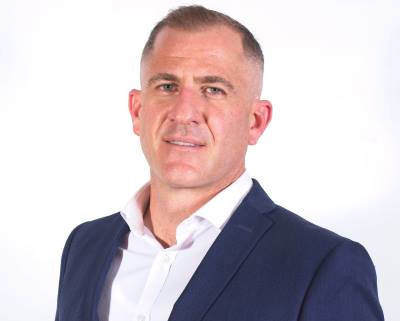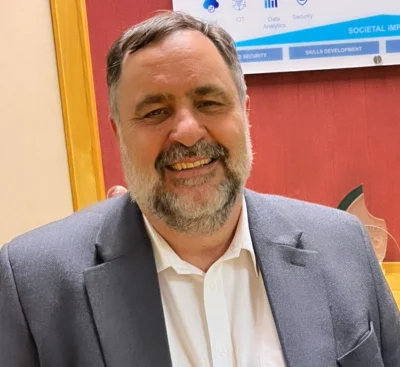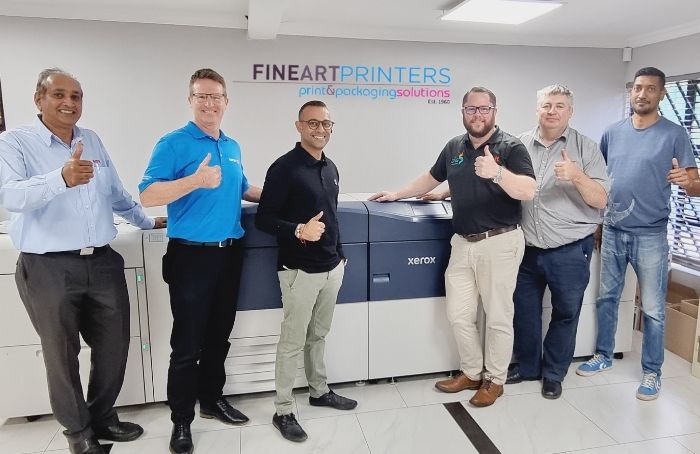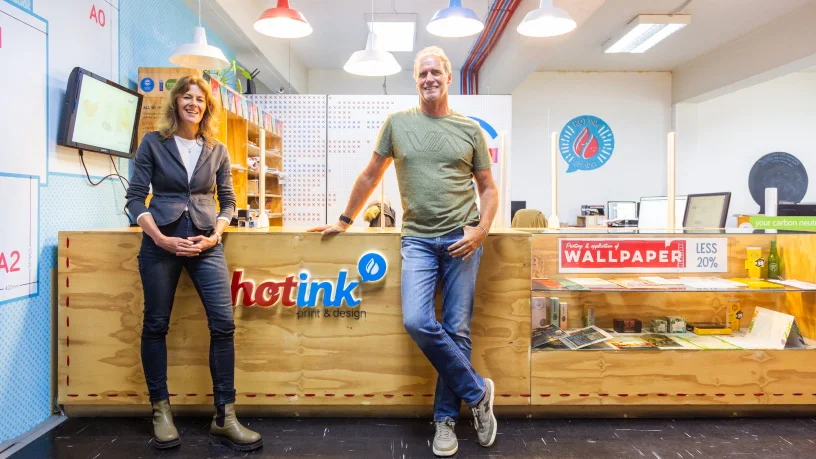For almost 25 years, co-founders Lisa Saville and Nic Johnson have been running Cape Town’s premier full-service printing centre, Hot Ink, like a tight ship. Located in the bustling heart of Cape Town’s CBD, Hot Ink has seen its share of challenges over the years, but has steadfastly retained the formula that continues to make it the go-to service for high-quality, colour-accurate printing in the city.
“I guess you could say we’re always looking for what we can add to what we already have, which is really the key if you want to be able to give everyone who walks through the door a high-value solution without sending them elsewhere,” says Saville.
“For example, before the pandemic and lockdowns of the last two years, we weren’t able to offer our clients any in-house bespoke packaging solutions, but now, with the combination of our heavy grammage-compatible Xerox printers and a recent investment in our own digital die-cutter, we can.”
Pointing to a shelf in the interview room stacked to the brim with packaging samples for local artisans and smaller boutique businesses, Saville says that while many companies have had to pivot and adapt to the ‘new normal’, Hot Ink didn’t have to change much to keep up with demand.
“We’ve been fortunate that our business model was always intended to cater to large numbers of smaller businesses as opposed to the other way round,” she says.
“When COVID hit, many larger companies shuttered their doors or downsized, leaving people having to find new ways to generate an income. When you have an idea that needs to be packaged before it can be sold, you need a way to turn the concept into reality, and that’s really what we’ve always done for our clients, on-screen and on paper and now with physical short-run packaging.”
In-house skills
According to Saville, many clients don’t even know the options available when it comes to presenting their products, so it’s up to Hot Ink’s in-house design team to help them create even better products from their original ideas.
“Not many other printers employ such a dedicated and qualified design team as part and parcel of their service offering,” she says.

“Design is very much at the heart of what we do and, as such, we felt it just as important to have the best designers as it was to have the best equipment. There’s a reason why so many ad agencies and design houses choose us for their printing, because we literally speak the same language. They don’t just come to us for technical printing solutions, but engage with us throughout the design process and trust us to honour their work through to its physical manifestation.”
Xerox partnership
“Part of Hot Ink’s ability to meet market demand head-on has been due to its longstanding relationship with Xerox,” says Johnson.
“In the early days, we worked with many of Cape Town’s leading model agencies (and still do), and as you can imagine they demand spot-on colour accuracy and skin tones every time,” he says.
“Working with a global brand like Xerox isn’t about showboating, but rather knowing that our investment in printing technology means we can count on reliability, consistency and – with Altron Document Solutions – expert service as and when we need it. It’s quite simple really, in this business we trade on solutions, not excuses, so we can’t be seen to be blaming our tools when things go wrong, which thankfully, they rarely ever do.”
Hot Ink was the first printer in South Africa to invest in the Xerox Iridesse platform in 2018, back when gold, silver and white ink printing was in its infancy in the short-run digital printing domain.

Co-founders Lisa Saville and Nic Johnson.
“At the time, we became the pioneers of embellished printing, offering short-run, lower-cost and quick turnaround solutions, previously only possible as part of costly high-volume print orders. If someone comes to us now needing to print black on black or white ink on black, or to accent their packaging with metallic inks, we are still one of the few companies that can do it. We even have other printers outsourcing work to us.” says Johnson.
Not only has Hot Ink actively invested in the latest technology, where it makes business sense, they’ve also invested in the necessary technical skills to maintain it.
“As with our design team, it makes such a big difference to have in-house technical skills on the equipment side. It’s what makes it possible for us to push the envelope when it comes to taking our machines to their full potential and beyond.
“For example, we’ve tried and successfully printed on artificial substrates that no one else has touched because they were told ‘it’s not laser compatible’, and yet we’ve made it work.”
Sustainably into the future
One of Hot Ink’s selling points is carbon neutrality – the company has been an officially certified carbon neutral business since 2012.
“It started with Nic and I thinking this would be a good thing to explore,” says Saville, “simply because we felt it was the right thing to do.”
“Once we achieved our certification and we put it out there, a lot of new customers found us and worked with us, who perhaps wouldn’t have done so without us being carbon neutral. Because there is a growing amount of company legislation that specifies that the procurement process must now be from sustainable suppliers, it has not only put us at the front of the queue when it comes to choosing printers, but it’s also pushed us to explore more sustainable print solutions.

“It’s pushed us to look for self-adhesive options that are recyclable. It’s pushed us to look at how we operate within Hot Ink. How do we package our products? Let’s not use bubble wrap, let’s use corrugated cardboard. Let’s not use clear plastic packaging tape, let’s use gummed tape. It’s also forced us to rethink the way we do things from within and what we can offer our customers on the outside.”
Johnson adds that one of the eco-friendly substrates Hot Ink has been using, called Rock Paper, is a waterproof stock made from minerals, which uses zero water for its production. During the pandemic this was particularly useful for printing items like menus that needed to be washed down regularly to comply with COVID-19 regulations.
“That’s just one example of many, but goes to show how innovation in one area often leads to innovations in other areas too.”
Looking ahead, both partners believe Hot Ink is on course to continue with its upward trajectory.
“We print business cards and brochures and booklets as our bread-and-butter, but we’ve never actively gone after the ‘low-cost, high-volume’ market, choosing instead to focus on smaller high-value clients with broad industry diversification,” says Saville.
“That’s why you’ll see a very wide range of clients passing through our door, people who come to us when they need to get things done that no one else can do. It’s the model we came up with when we were young and passionate with little industry knowledge and which fortunately still holds true now that we have the experience and track record to show for it.”
Altron Document Solutions
Altron Document Solutions (ADS) is Africa’s leading document management technology and services company and the largest Xerox distributor in the world. It is the authorised Xerox distributor in 26 sub-Saharan countries offering the complete range of Xerox document equipment, software solutions and services. ADS forms part of JSE-listed Altron Limited.
https://www.bdsol.co.za/
Xerox Corporation
Xerox Holdings Corporation (NYSE: XRX) makes every day work better. We are a workplace technology company building and integrating software and hardware for enterprises large and small. As customers seek to manage information across digital and physical platforms, Xerox delivers a seamless, secure and sustainable experience. Whether inventing the copier, Ethernet, the laser printer or more, Xerox has long defined the modern work experience. Learn how that innovation continues at xerox.com.






